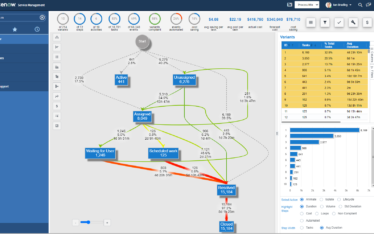The evolution of process mining software…
Commercial process mining software, along with the capabilities and business benefits of process mining, was introduced to the business world just over 10 years ago. Original vendors were based in Europe, often with academic ties, and focused on financial processes such as Procure to Pay and Order to Cash. The software was essentially force directed graphs (FDGs) that enabled visualisation of the variants, steps and activities in a process.
Over the years, process mining has evolved into an Enterprise Software environment, with multiple large successful vendors. Celonis, the market leader, is now a multi-billion-dollar company. The capabilities offered extend beyond FDGs, with artificial intelligence , collaboration, root cause analytics, multiple data connectors offered, etc.
With process mining being a relatively new concept, current vendors not only had to develop software, but also sell the value of process mining to the business world. All indications are that process mining, and the associated digital automation, compliance management, cost control and performance analysis capabilities are now understood by people involved in process optimisation.
So, what next? What is the future for process mining software? Here are some predictions.
Commoditization…
Successful commodity software is function rich, cheap, readily available and easy to purchase. Think Microsoft PowerBI. A pure SaaS based Business Intelligence offering costing around 10 USD per month. It’s easy to sign-up and be up and running within minutes. The software is online and regularly updated. There is no need for face to face or expensive training as video tutorials are available.
But 10-15 years ago, Business Intelligence software was predominantly an enterprise offering. Prices more than 20K per year per user were common, with enterprise sales > 1M USD. Sales cycles were time intensive, and there was no option to buy online.
The same scenario goes for other types of software e.g., service management and accounting. And the same will happen to process mining software. Will it become as mainstream and cheap as PowerBI, unlikely, but the tide will turn away from enterprise sales to a SaaS based, lower cost subscription model
Acquisitions…
Large software and process mining vendors will buy smaller vendors to accelerate market entry, add resources and capabilities to existing products, and to eliminate competitors. We have seen such activity recently with the Microsoft purchase of Minit, and Celonis purchase of PAFNow.
Acquisitions are symbolic of any fast-growing software environment and are often a tactic used by larger, positioned vendors to protect against commoditization of their offerings brought about by new offerings. These new offerings are built with the latest technology available as SaaS and do not have legacy components prohibiting rapid upgrade cycles
Embedding process mining capabilities within enterprise applications…
As process mining becomes more mainstream, existing enterprise software vendors will look to embed process mining functionality within their applications, as opposed to having their users buy expensive enterprise process mining software solutions. Process mining software vendors that architect their solutions to enable seamless integration into other software platforms could potentially cause significant disruption to the business models of larger established process mining vendors
Increased focus on useability…
Like many software journeys, the process mining journey to date has focussed on vendors essentially telling the users what they need, and then providing these needs i.e., building and establishing the market. As end users increase and become more proficient with the analytics driving process mining, the users will insist on more usable, dynamic and engaging products. Process mining software vendors will need to rapidly respond to new user requirements and have an architecture enabling this response. The PowerBI monthly upgrade cycle is a good example of this.
A proliferation of fresh marketing terms…
In efforts to market process mining and delineate from the competition, there will be a range of unfamiliar terms made up and names of product offerings changed. But at the end of the day, it’s about process automation, compliance, cost control and performance. And they are driven by process mining software
Metricus is positioned for these challenges…
These predictions necessitate change, and with change comes challenges. These challenges are what has driven the evolution of the Metricus Process Miner offerings.
- The Metricus Process Miner is a pure SaaS offering. Users can subscribe with a credit card and be up and running within minutes. Monthly and yearly subscriptions are available, and a comprehensive library of video tutorials enables self-service training.
- Metricus was designed from the ground-up for seamless integration into other software applications. The Metricus Process Miner for ServiceNow is an example of this. A client side React Javascript application that uses secure Rest API calls to interact with the server data of the enterprise software. This is the real potential future for process mining software
- Metricus was designed and built by process mining practitioners. The focus was on building a process mining software application that provides an engaging and interactive process exploration environment. Why not try it out and sign up for a free trial at https://processminer.metricus.com !
Ian Bradley
Principal, Metricus

